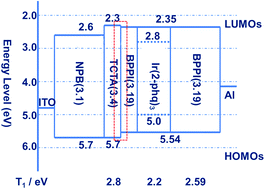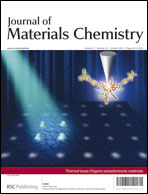In this work, derivatives of indolizine are first used as electron-transporting host materials for hybrid fluorescence/phosphorescence white organic light-emitting devices (F/P-WOLED). Of the indolizine derivatives, a blue fluorescent material BPPI (3-(4,4′-biphenyl)-2-diphenylindolizine) was found to have: (1) blue emission with high quantum yields, (2) good morphological and thermal stabilities, (3) electron-transporting properties, and (4) a sufficiently high triplet energy level to act as a host for red or yellow-orange phosphorescent dopants. The multifunctional BPPI enables adaptation of several simplified device configurations. For example, a non-doped blue fluorescent device exhibits good performance with an external quantum efficiency of 3.16% and Commission Internationale de l'Eclairage coordinates of (0.15, 0.07). A high-performance orange phosphorescent device was found to have a high current efficiency of 23.9 cd A−1. Using BPPI, we also demonstrate a F/P-WOLED with a simplified structure, stable emissions and respectable performance (current and external quantum efficiencies of 17.8 cd A−1 and 10.7%, respectively).

You have access to this article
 Please wait while we load your content...
Something went wrong. Try again?
Please wait while we load your content...
Something went wrong. Try again?


 Please wait while we load your content...
Please wait while we load your content...